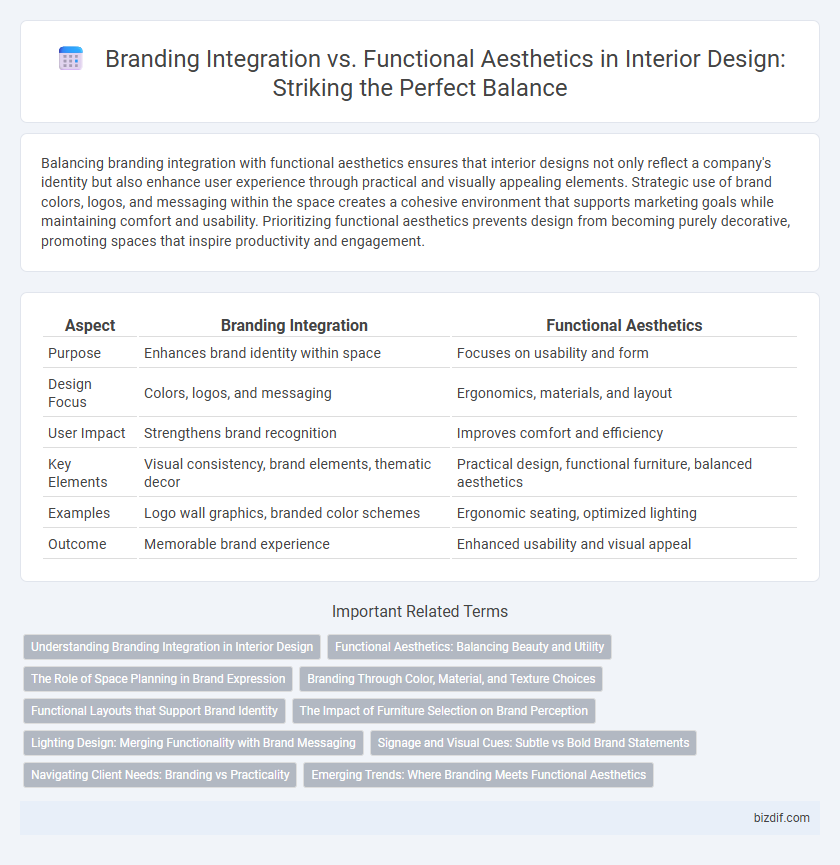Balancing branding integration with functional aesthetics ensures that interior designs not only reflect a company's identity but also enhance user experience through practical and visually appealing elements. Strategic use of brand colors, logos, and messaging within the space creates a cohesive environment that supports marketing goals while maintaining comfort and usability. Prioritizing functional aesthetics prevents design from becoming purely decorative, promoting spaces that inspire productivity and engagement.
Table of Comparison
| Aspect | Branding Integration | Functional Aesthetics |
|---|---|---|
| Purpose | Enhances brand identity within space | Focuses on usability and form |
| Design Focus | Colors, logos, and messaging | Ergonomics, materials, and layout |
| User Impact | Strengthens brand recognition | Improves comfort and efficiency |
| Key Elements | Visual consistency, brand elements, thematic decor | Practical design, functional furniture, balanced aesthetics |
| Examples | Logo wall graphics, branded color schemes | Ergonomic seating, optimized lighting |
| Outcome | Memorable brand experience | Enhanced usability and visual appeal |
Understanding Branding Integration in Interior Design
Branding integration in interior design seamlessly weaves a company's identity into spatial elements, creating environments that reflect core values and enhance customer experience. By incorporating logos, color palettes, and brand-specific textures, interiors become immersive brand stories rather than mere functional spaces. This strategic approach strengthens brand recognition and emotional connections while maintaining aesthetic appeal and usability.
Functional Aesthetics: Balancing Beauty and Utility
Functional aesthetics in interior design seamlessly blend visual appeal with practical utility, ensuring spaces are both beautiful and purposeful. Emphasizing ergonomic layouts, durable materials, and user-friendly features enhances everyday functionality without compromising style. Balancing these elements creates environments that support comfort and efficiency while maintaining an elegant, cohesive brand identity.
The Role of Space Planning in Brand Expression
Space planning plays a critical role in aligning branding integration with functional aesthetics by strategically organizing interior elements to reflect a brand's identity while enhancing usability. Effective space planning balances visual storytelling and operational flow, ensuring brand colors, logos, and thematic motifs are cohesively embedded within an accessible and comfortable environment. Thoughtful arrangement of furniture, lighting, and signage transforms physical space into a dynamic extension of brand values, fostering emotional connections and memorable customer experiences.
Branding Through Color, Material, and Texture Choices
Effective branding integration in interior design relies on strategic selection of color palettes, materials, and textures that embody a company's identity and values. Consistent use of signature colors and tactile elements reinforces brand recognition while creating a cohesive sensory experience. Balancing bold brand-specific hues with functional materials ensures interiors are both visually striking and practical for everyday use.
Functional Layouts that Support Brand Identity
Functional layouts that support brand identity enhance customer experience by seamlessly integrating spatial design with the core values and visual elements of the brand. Strategic placement of key areas and optimized traffic flow foster intuitive navigation, reinforcing brand messaging through spatial organization. This approach balances aesthetic appeal with purposeful design, ensuring every element serves both style and function to create a cohesive, immersive brand environment.
The Impact of Furniture Selection on Brand Perception
Furniture selection plays a crucial role in defining brand perception by seamlessly integrating branding elements with functional aesthetics. Choosing pieces that reflect the company's values, color palette, and style enhances brand identity while maintaining comfort and usability. Thoughtful furniture choices create immersive environments that communicate professionalism and strengthen client trust.
Lighting Design: Merging Functionality with Brand Messaging
Lighting design in interior spaces balances functional aesthetics with branding integration by using customized fixtures and color temperatures that enhance both usability and brand identity. Strategic placement of lights directs attention to key architectural features while reinforcing the brand's visual language through consistency in style and intensity. Incorporating dynamic lighting controls allows adaptation to different brand narratives and operational needs, creating an immersive environment that aligns with marketing goals and user experience.
Signage and Visual Cues: Subtle vs Bold Brand Statements
Signage and visual cues in interior design balance branding integration and functional aesthetics by choosing between subtle and bold brand statements. Subtle signage uses minimalist design and neutral colors to blend branding seamlessly into the environment, enhancing user experience without overwhelming the space. Bold visual cues employ vivid colors, prominent logos, and dynamic typography to create strong brand recognition while guiding movement and highlighting key areas.
Navigating Client Needs: Branding vs Practicality
Balancing branding integration with functional aesthetics requires a deep understanding of client priorities and spatial usage. Effective interior design merges brand identity elements, such as color schemes, logos, and messaging, with practical features like ergonomics, lighting, and layout efficiency. Tailoring solutions to emphasize either branding or functionality depends on the project's purpose, whether it's retail, office, or hospitality environments.
Emerging Trends: Where Branding Meets Functional Aesthetics
Emerging trends in interior design emphasize the seamless integration of branding elements with functional aesthetics, creating spaces that reflect a company's identity while enhancing usability. Innovative materials and customized furnishings are leveraged to reinforce brand narratives subtly within everyday environments, ensuring that design serves both visual impact and operational efficiency. This convergence of branding and functionality drives immersive experiences that resonate with users and support business objectives simultaneously.
branding integration vs functional aesthetics Infographic

 bizdif.com
bizdif.com